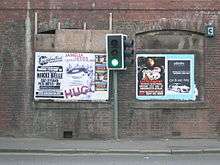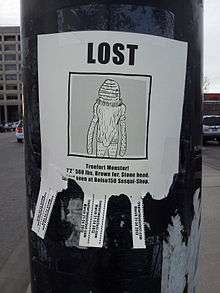Flyposting



Flyposting (sometimes known as wild posting or bill posting) is a guerrilla marketing tactic through the act of placing advertising posters or flyers in legal or illegal places. In the United States, these posters are also commonly referred to as wheatpaste posters because wheatpaste is often used to adhere the posters. Posters are adhered to construction site barricades, building façades and in alleyways.
About
The posters used are typically made of a lightweight paper and printed using flexography, digital printing and screen printing. Modern printing techniques enable the posters to feature full-colour designs, halftones, and photographs, making them popular for advertising concerts, political messages, commercial advertisements and special events. An increasing number of posters do not advertise anything at all and instead feature artwork, inspirational or positive messages, and religious messages.
It is an advertising tactic mostly used by small businesses promoting concerts and political activist groups, but there have been occasions where international companies subcontracted local advertising agencies for flyposting jobs in order not to get caught in illegal behavior, as a form of guerrilla marketing. In 2004, Sony Music and BMG were threatened with anti-social behaviour orders by Camden Borough Council for illegal flyposting.[1]
In most areas, it is illegal to place such posters on private property without the consent of the property owner, or to post on public property without a sign permit from the local government. Some areas, however, have public bulletin boards where notices may be posted. In an effort to discourage illegal flyposting, surfaces at risk of it are sometimes permanently signed Post No Bills (USA), No Flyposting (UK), or in France Défense d'afficher - loi du 29 juillet 1881, referring to a law on freedom of the press and related matters enacted then and subsequently much amended.
While flyposting is commonplace, it is often viewed as a nuisance due to issues with property rights. In India, the Election Commission has banned this practice, but it continues unabated.
A particularly noteworthy incident of this type occurred in Boston, Massachusetts. In the case of the 2007 Boston Mooninite Scare, advertisers had placed electronic signboards without notifying local authorities, prompting a costly reaction by the Boston Police Bomb Squad when the signs were mistaken for bombs.[2]
With the rise of technology, much of advertising has been shifted to the Internet. Some have drawn similarities between flyposting and certain types of adware, which are more invasive to users but generate a similar "guerrilla" effect.[3]
See also
References
- ↑ "Top music chiefs are spared ASBOs". BBC. 14 June 2004. Retrieved 2008-10-21.
- ↑ Smalley, Suzanne; Mishra, Raja (February 1, 2007). "Froth, fear, and fury". The Boston Globe. The New York Times Company. Archived from the original on February 22, 2011. Retrieved February 2, 2007.
- ↑ "Flyposting". Wild Posting. Retrieved 24 April 2016.
Further reading
- "Stanhope targets unsightly, illegal bill posting". Australian Capital Territory Government. 10 December 2008. Retrieved 2009-07-31.
- Dunlap, David W (24 March 2008). "City Room: Illegal Signs and a Reporter's Broken Camera". The New York Times. Retrieved 2009-07-31.